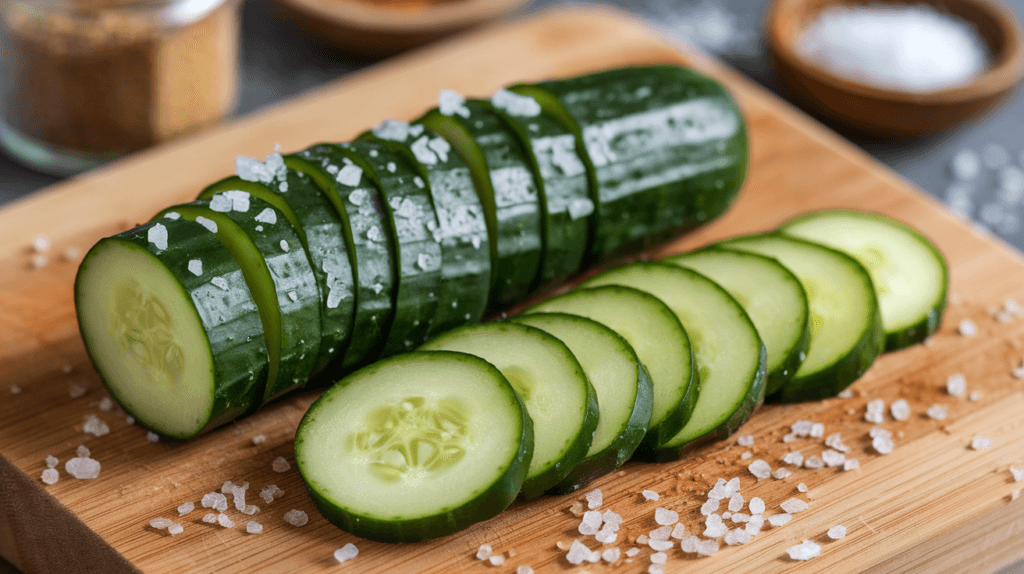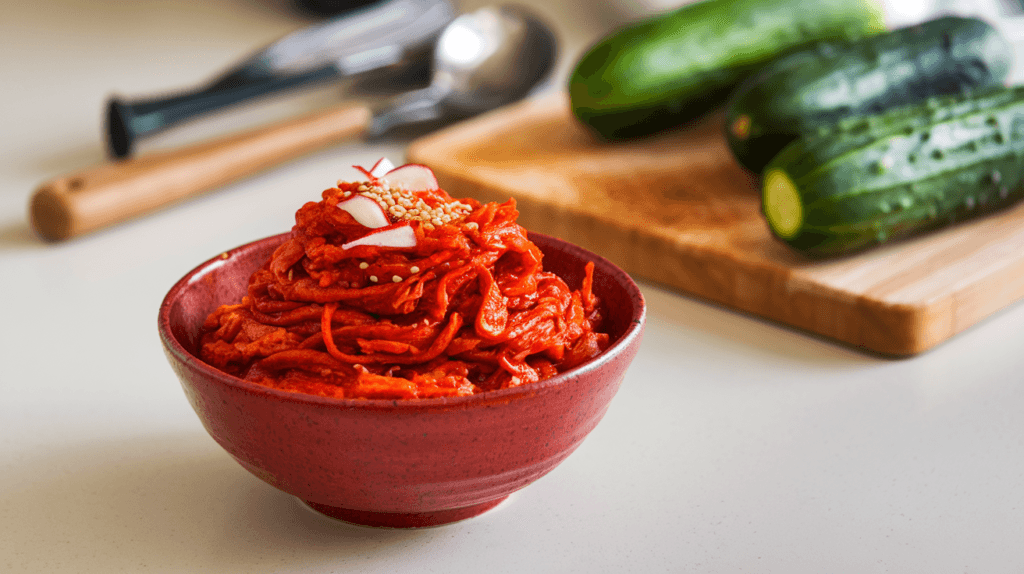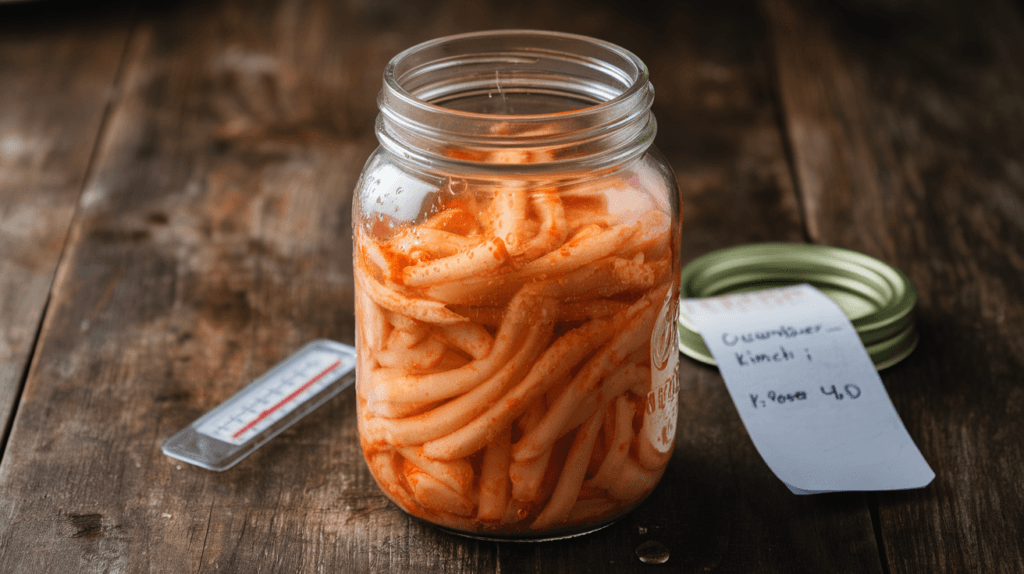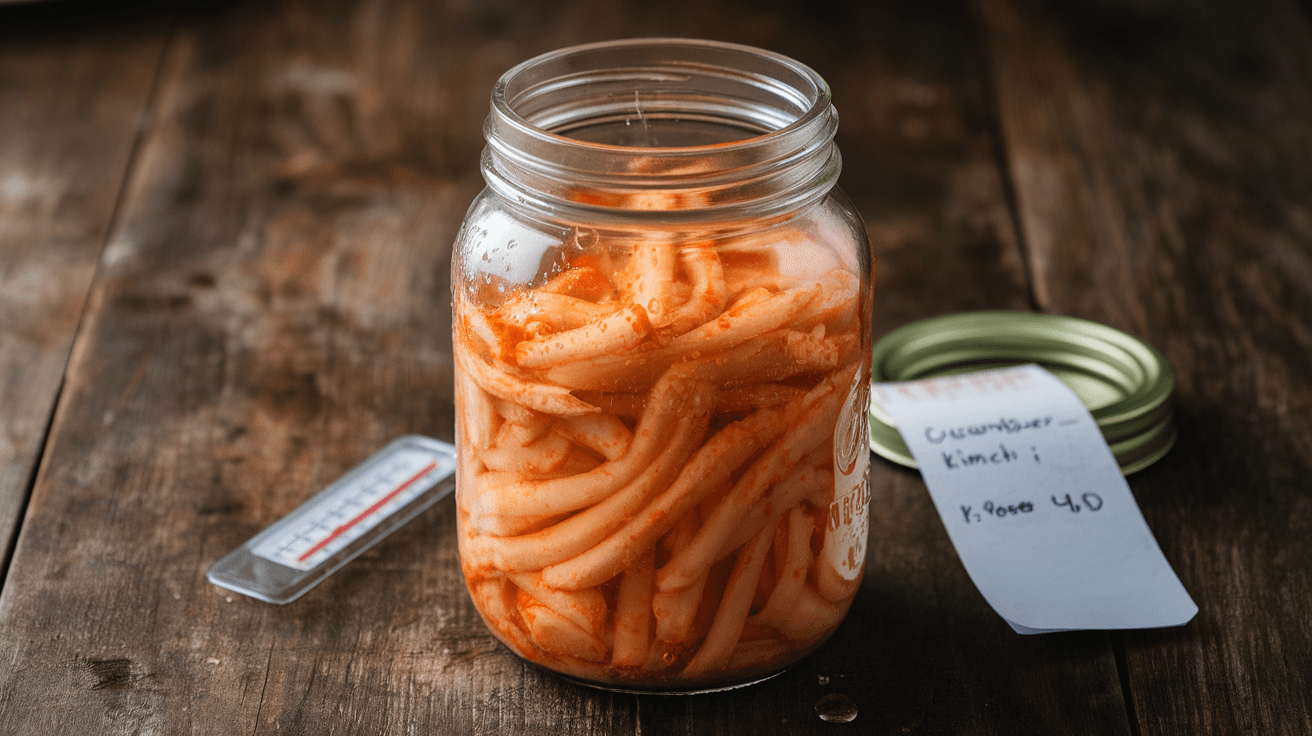Introduction
Cucumber kimchi is a refreshing and flavorful variant of traditional kimchi. However, many people encounter a common issue: excess water. This can dilute the flavors and reduce the quality of your homemade kimchi. If you’ve struggled with watery cucumber kimchi, don’t worry! In this guide, we’ll dive into the reasons behind the problem and provide practical tips to keep your kimchi perfectly balanced and delicious.
By following these tried-and-true methods, you’ll ensure your cucumber kimchi retains its texture, vibrant flavors, and a longer shelf life. Let’s explore the secrets to mastering this unique dish!
Understanding the Problem: Why Cucumber Kimchi Becomes Watery
Causes of Excess Water in Kimchi
Watery cucumber kimchi is often the result of improper preparation techniques or ingredient selection. Cucumbers, being naturally high in water content, release moisture during the fermentation process. If the excess water is not managed, it can dilute the seasoning paste and impact the overall taste and texture of the kimchi.
Another common reason is over-salting or under-salting during the initial steps. Salt draws water out of the cucumbers, but if this step is rushed or uneven, the moisture won’t be removed effectively.
The Role of Cucumbers in Water Content
Cucumbers are about 95% water, which makes them a challenging vegetable to work with in fermented dishes. The type of cucumber you choose—such as English cucumbers or Persian cucumbers—can also affect how much water is released. Some varieties are naturally juicier, leading to more watery results.
Understanding these factors is crucial to tackling the problem and ensuring your cucumber kimchi stays flavorful and balanced.
Key Steps to Prevent Watery Cucumber Kimchi
Salting Cucumbers Properly

Salting is one of the most important steps in preventing watery cucumber kimchi. Proper salting helps draw out excess moisture from the cucumbers before the fermentation process begins. Here’s how to do it:
- Slice the cucumbers into your desired shapes and sizes.
- Sprinkle coarse sea salt evenly over the cucumber pieces, ensuring each piece is coated.
- Let the cucumbers sit for at least 30 minutes, occasionally tossing them to ensure even salting.
- Rinse the cucumbers thoroughly under cold water to remove excess salt before mixing them with the kimchi paste.
This step significantly reduces the water content in the cucumbers, creating a firmer texture that holds up better during fermentation.
Choosing the Right Cucumbers
The type of cucumber you use can make a big difference. For less watery kimchi, opt for firmer varieties with lower water content, such as:
- Kirby Cucumbers: Known for their crunchy texture and reduced water content, these are ideal for pickling and fermentation.
- Persian Cucumbers: These are smaller and firmer, making them a great choice for cucumber kimchi.
- Avoid English Cucumbers: While popular, they tend to have thinner skins and higher water content, leading to watery results.
Using the right cucumbers ensures better texture and minimizes excess liquid during fermentation.
Adjusting the Kimchi Brining Process
Optimal Time for Brining Cucumbers
The brining process plays a critical role in reducing water content in cucumber kimchi. If you’re wondering how to make cucumber kimchi less watery, allowing the cucumbers to brine for the right amount of time is essential. This step ensures that excess moisture is properly drawn out. Follow these guidelines for optimal results:
- For thinly sliced cucumbers, brine for 20–30 minutes.
- For thicker cuts or whole cucumbers, brine for 1–2 hours.
- Ensure the cucumbers are evenly coated with salt and that they rest in a colander or bowl to drain effectively.
Patience is key—rushing the brining process may leave too much moisture in the cucumbers, leading to watery kimchi.
Using Appropriate Salt Quantities
The type and amount of salt you use can directly affect the brining process. Here are some tips for success:
- Coarse Sea Salt: This is the preferred salt for kimchi as it dissolves slowly and draws out moisture effectively.
- Use Moderate Quantities: Avoid oversalting, which can make the kimchi too salty, or undersalting, which may not remove enough water.
- For every 2 pounds (about 1 kg) of cucumbers, use about 2–3 tablespoons of salt.
Proper salt distribution ensures the cucumbers are well-prepped for fermentation while reducing their water content significantly.
Enhancing the Kimchi Paste Consistency

Adding Thickeners to the Paste
A thick kimchi paste can help counteract excess water released during fermentation. Incorporating natural thickeners into your paste improves the texture and flavor balance. Consider the following options:
- Rice Flour Paste: Make a slurry using rice flour and water, cooking it until it thickens. Mix it into your kimchi seasoning for added body.
- Grated Vegetables: Ingredients like carrots or radishes, when grated finely, can add thickness and absorb extra moisture.
- Ground Sesame Seeds: These not only thicken the paste but also enhance the flavor profile.
Using these thickeners ensures the kimchi paste clings to the cucumbers, reducing water pooling at the bottom of your container.
Using Less Liquid Ingredients
Minimizing the amount of liquid in your seasoning paste is another effective way to control moisture. Here’s how:
- Reduce Soy Sauce: If your recipe calls for soy sauce, consider using a smaller quantity or omitting it entirely.
- Limit Fish Sauce: While essential for authentic flavor, using too much fish sauce can increase the liquid content.
- Blend Ingredients Thoroughly: When making your paste, aim for a thick, cohesive mixture by thoroughly blending ingredients like garlic, ginger, and chili powder.
These adjustments help create a more stable kimchi paste, ensuring it doesn’t become overly watery during fermentation.
Storage Tips for Less Watery Kimchi

Proper Containers for Fermentation
The type of container you use for fermenting cucumber kimchi can significantly influence its moisture levels. To minimize excess water, follow these tips:
- Airtight Containers: Use airtight glass or plastic containers to prevent external moisture from affecting the fermentation process.
- Pressing Down Ingredients: After adding the kimchi paste, firmly press the cucumbers down to eliminate air pockets and reduce liquid accumulation.
- Avoid Overfilling: Leave about 1–2 inches of space at the top of the container to allow for gas expansion during fermentation.
Proper storage ensures a balanced fermentation process and prevents excess water from pooling at the surface.
Ideal Storage Temperatures
The temperature at which you ferment your cucumber kimchi can also affect its texture and water content. Here’s what to keep in mind:
- Cool Temperatures: Ferment the kimchi at a cool room temperature (65°F–75°F or 18°C–24°C) for 1–2 days before transferring it to the refrigerator.
- Refrigeration: Store the kimchi in the refrigerator at around 35°F–40°F (1.5°C–4.5°C) to slow down the fermentation process and reduce the likelihood of water release.
- Avoid Temperature Fluctuations: Keep the kimchi away from heat sources and direct sunlight to maintain consistency.
By following these storage practices, you’ll extend the shelf life of your cucumber kimchi while keeping it firm and flavorful.
Troubleshooting Watery Cucumber Kimchi
Fixing Watery Kimchi After It’s Made
If your cucumber kimchi has already turned watery, don’t worry—there are simple ways to fix it. Here are some quick solutions:
- Drain Excess Liquid: Carefully pour off the excess liquid from the container without disturbing the kimchi too much.
- Thicken the Paste: Add a small amount of thickened rice flour paste or grated vegetables (e.g., carrots or radish) to the kimchi and mix gently.
- Transfer to a Smaller Container: Compact the kimchi into a smaller, airtight container to minimize air exposure and slow further liquid release.
These steps can help restore balance and improve the texture of your kimchi.
Tips for Better Fermentation Results
To prevent future issues with watery cucumber kimchi, keep these tips in mind during preparation:
- Don’t Skip Salting: Ensure the cucumbers are adequately salted and drained before mixing with the paste.
- Use Balanced Ingredients: Avoid overloading the paste with watery components, and stick to recipes with well-measured ratios.
- Monitor Fermentation Time: Over-fermenting cucumber kimchi can result in excessive water release, so watch for the optimal fermentation period.
These best practices will help you consistently achieve perfectly balanced cucumber kimchi.
How to Serve and Enjoy Cucumber Kimchi
Pairing Cucumber Kimchi with Meals
Cucumber kimchi is a versatile side dish that complements a wide variety of meals. Its crisp texture and tangy, spicy flavors make it an excellent addition to:
- Rice Dishes: Pair it with steamed white or brown rice for a simple yet satisfying combination.
- Barbecue: Serve it alongside grilled meats like bulgogi or galbi to balance the rich flavors.
- Soups and Stews: Add cucumber kimchi as a refreshing side to hearty Korean soups such as doenjang jjigae or kimchi jjigae.
This side dish enhances the flavors of main courses while providing a crunchy, refreshing contrast.
Creative Uses for Cucumber Kimchi
Aside from traditional pairings, cucumber kimchi can also be used in creative ways to elevate other dishes. Here are some ideas:
- Wraps and Rolls: Use it as a filling for lettuce wraps or as a topping in sushi rolls for an extra kick.
- Salads: Chop the cucumber kimchi into small pieces and mix it with greens for a unique salad.
- Tacos: Add cucumber kimchi to tacos for a fusion twist that combines spice and crunch.
- Sandwiches: Layer it in sandwiches or burgers to add a tangy, spicy note.
With its bold flavors and crunchy texture, cucumber kimchi can elevate any meal from ordinary to extraordinary!
Common Mistakes to Avoid When Making Cucumber Kimchi
Skipping the Salting Process
One of the most frequent mistakes is skipping or rushing the salting process. Salting is essential to draw out excess moisture from the cucumbers, ensuring they maintain a firm texture during fermentation. Failing to salt properly can lead to watery, bland kimchi.
Using the Wrong Cucumber Type
Choosing the wrong type of cucumber, such as overly watery or soft varieties, can result in soggy kimchi. Always opt for firm, low-water-content cucumbers like Kirby or Persian cucumbers for the best results.
Overloading with Liquid Ingredients
Adding too much soy sauce, fish sauce, or other liquid ingredients to the paste can increase the overall water content. Stick to the recommended quantities in your recipe to maintain a thick and cohesive kimchi paste.
Over-Fermenting the Kimchi
Leaving cucumber kimchi to ferment for too long at room temperature can cause it to release excessive water and lose its crunch. Monitor the fermentation process closely and transfer the kimchi to the refrigerator once it reaches your desired flavor.
Improper Storage
Using non-airtight containers or exposing the kimchi to fluctuating temperatures can lead to uneven fermentation and watery results. Always store cucumber kimchi in a well-sealed container and maintain a consistent storage temperature.
By avoiding these common mistakes, you can create cucumber kimchi that’s crisp, flavorful, and perfectly balanced every time!
FAQs
Why does cucumber kimchi become watery?
Cucumber kimchi becomes watery due to the high water content in cucumbers, combined with improper salting or brining techniques. As cucumbers release moisture during fermentation, excess liquid can dilute the kimchi paste if not managed correctly.
How can I fix watery cucumber kimchi?
You can fix watery cucumber kimchi by draining the excess liquid, adding a thickened paste (such as rice flour or grated vegetables), and storing it in a smaller, airtight container to reduce further water release.
What type of cucumbers are best for kimchi?
Firm cucumbers with lower water content, such as Kirby or Persian cucumbers, are best for making cucumber kimchi. Avoid using varieties with thin skins and high water content, like English cucumbers, as they tend to produce watery results.
Can I skip the salting step when making cucumber kimchi?
No, salting is essential for drawing out excess moisture from cucumbers and ensuring the kimchi stays crisp and less watery. Skipping this step can result in soggy kimchi with diluted flavors.
How long should I ferment cucumber kimchi?
Ferment cucumber kimchi at room temperature for 1–2 days, then transfer it to the refrigerator for long-term storage. Over-fermentation can lead to excess water release, so monitor the texture and taste to determine the optimal time.
Can I use cucumber kimchi as a base for other dishes?
Yes, cucumber kimchi is versatile and can be used in various dishes, such as salads, tacos, wraps, and sandwiches. Its bold flavors and crunchy texture make it a great addition to many recipes.
Conclusion
Making cucumber kimchi less watery is a matter of understanding the ingredients, preparation techniques, and storage methods. By salting cucumbers properly, adjusting the brining process, enhancing the paste consistency, and storing the kimchi correctly, you can significantly reduce excess water and improve the overall quality of your dish.
Whether you’re a seasoned kimchi maker or trying it for the first time, these tips will ensure that your cucumber kimchi turns out flavorful, crisp, and perfectly balanced. Give these methods a try and enjoy your homemade masterpiece!

